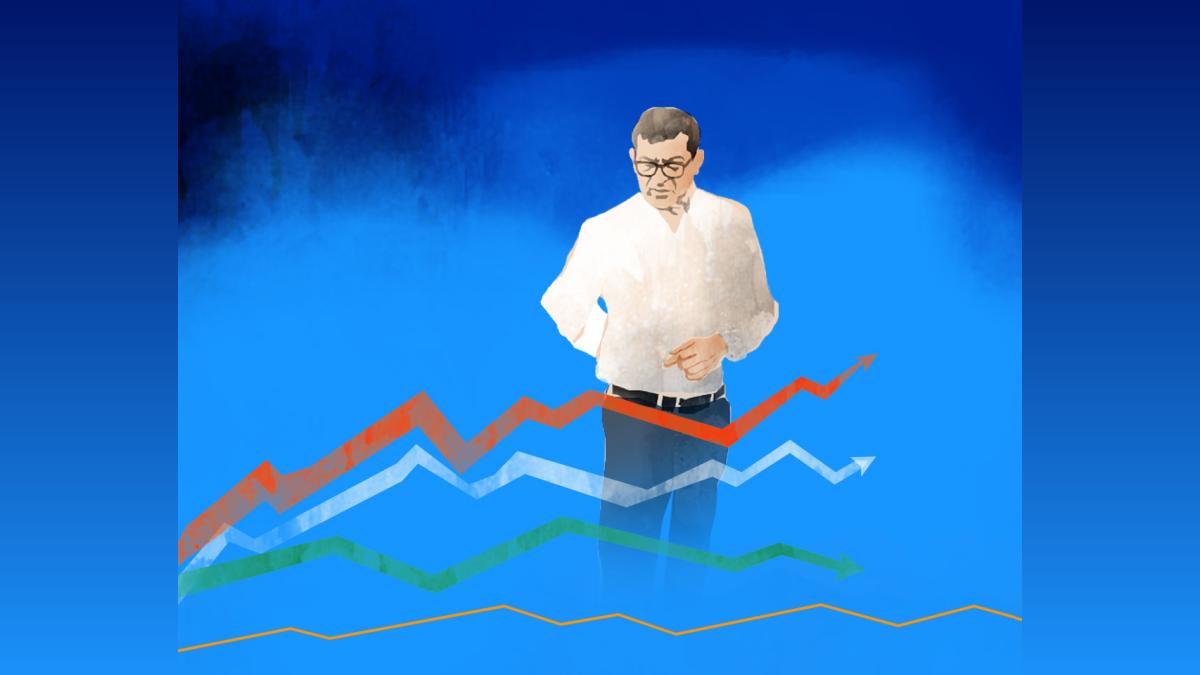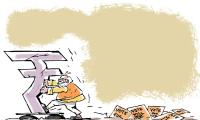India's GDP Uptick: Rajan on Infra Spending & Economic Growth
Raghuram Rajan attributes India's GDP growth to infrastructure spending and global economic performance, but warns about slow job creation and the USD 5 trillion economy goal.

Illustration: Dominic Xavier/Rediff.com
New Delhi, Dec 13 (PTI) Former RBI governor Raghuram Rajan has attributed the sharp uptick in GDP in the first half of the current fiscal to infrastructure spending and good performance by large economies of the world but added India has to do a lot of catching up and the USD 5 trillion economy goal for 2025 is nearly impossible.
Rajan further said that even as India's growth rate is strong, private investment and private consumption have not picked up.
"So if you look at why we have done so well this year, one of the reasons we are doing so well is also because the world is doing well.
"... the other reason for this very strong growth in the first half is tremendous government spending on infrastructure," Rajan told PTI.
India retained the tag of the world's fastest-growing major economy, with its GDP expanding by a faster-than-expected rate of 7.6 per cent in the July-September quarter on booster shots from government spending and manufacturing.
At constant (2011-12) prices in April-September 2023-24 (H1 2023-24), GDP is estimated at Rs 82.11 lakh crore as against Rs 76.22 lakh crore during the corresponding period of the previous year, showing a growth of 7.7 per cent in H1 2023-24 as against 9.5 per cent in H1 2022-23.
He noted that over the last four years, from the pre-pandemic days till today, the Indian economy has grown about 4 per cent a year.
"That is way below our growth potential (economic growth rate) of 6 per cent.
"So you said inflation is contained. One of the reasons inflation is contained is we haven't even grown at our potential rate," Rajan, presently Katherine Dusak Miller Distinguished Service Professor of Finance at Chicago Booth (USA), observed.
The eminent economist emphasised that India needs to grow much faster as the worrying fact that the growth is not providing enough jobs.
"We are about 5 per cent below our trendline which was the pre-pandemic trendline. So there is some catch-up to be done at this point," he said.
Noting that for democracy to work, the government needs to share the data with the people, he said, "You can not simply pull numbers out of a hat and say...we will be a USD 5 trillion economy by 2025."
According to Rajan, it is virtually impossible for India to become a USD 5 trillion economy by 2025 unless a "miracle" happens.
"Because we are now maybe USD 3.5 trillion economy, to be a USD 5 trillion economy, you have to grow at 12 to 15 per real growth rate over the next two years," he explained.
Rajan wondered whether the government has any plan for increasing India's economic growth from the current 6 per cent-plus to 12-15 per cent.
"So you need some sensible discussion in public...you have to take economists into your conference," he suggested
Replying to a question on his earlier prediction that India is 'dangerously close' to the Hindu rate of growth, Rajan said he was right to worry that India's economic growth had slowed down.
"I think the word 'Hindu rate of growth' was unfortunate because it also created connotations," he said
According to him, it was a technical term, which was used by economist Dr Raj Krishna in 1978 to describe the slow growth of 3.5 per cent
A "4 per cent growth which I mentioned just now in the last four years, (is) not that different from three-and-a-half per cent growth," Rajan said, adding that the country needs to grow much faster.
He opined that the reality is whatever rate India is growing up currently is not enough.
Noting that only way India's demographic dividend will become a dividend, if the country creates enough jobs, Rajan said, "let us focus on that instead of worrying about every quarters growth, which can be opened up."
Earlier this year, sounding a note of caution, Rajan said that India is "dangerously close" to the Hindu rate of growth in view of subdued private sector investment, high-interest rates and slowing global growth.
On production linked incentive (PLI) scheme, Rajan likened the implementation of the scheme to pre-economic liberalisation days when successive governments used to constantly intervene and provide favour and give subsidies to some sectors of the industry.
"Why do we think it will work out today when it did not work out in the past," he asked.
The scheme was announced in 2021 for 14 sectors such as telecommunication white goods, textiles, manufacturing of medical devices, automobiles, speciality steel, food products, high-efficiency solar PV modules, advanced chemistry cell batteries, drones and pharma.
Rajan further said that even as India's growth rate is strong, private investment and private consumption have not picked up.
"So if you look at why we have done so well this year, one of the reasons we are doing so well is also because the world is doing well.
"... the other reason for this very strong growth in the first half is tremendous government spending on infrastructure," Rajan told PTI.
India retained the tag of the world's fastest-growing major economy, with its GDP expanding by a faster-than-expected rate of 7.6 per cent in the July-September quarter on booster shots from government spending and manufacturing.
At constant (2011-12) prices in April-September 2023-24 (H1 2023-24), GDP is estimated at Rs 82.11 lakh crore as against Rs 76.22 lakh crore during the corresponding period of the previous year, showing a growth of 7.7 per cent in H1 2023-24 as against 9.5 per cent in H1 2022-23.
He noted that over the last four years, from the pre-pandemic days till today, the Indian economy has grown about 4 per cent a year.
"That is way below our growth potential (economic growth rate) of 6 per cent.
"So you said inflation is contained. One of the reasons inflation is contained is we haven't even grown at our potential rate," Rajan, presently Katherine Dusak Miller Distinguished Service Professor of Finance at Chicago Booth (USA), observed.
The eminent economist emphasised that India needs to grow much faster as the worrying fact that the growth is not providing enough jobs.
"We are about 5 per cent below our trendline which was the pre-pandemic trendline. So there is some catch-up to be done at this point," he said.
Noting that for democracy to work, the government needs to share the data with the people, he said, "You can not simply pull numbers out of a hat and say...we will be a USD 5 trillion economy by 2025."
According to Rajan, it is virtually impossible for India to become a USD 5 trillion economy by 2025 unless a "miracle" happens.
"Because we are now maybe USD 3.5 trillion economy, to be a USD 5 trillion economy, you have to grow at 12 to 15 per real growth rate over the next two years," he explained.
Rajan wondered whether the government has any plan for increasing India's economic growth from the current 6 per cent-plus to 12-15 per cent.
"So you need some sensible discussion in public...you have to take economists into your conference," he suggested
Replying to a question on his earlier prediction that India is 'dangerously close' to the Hindu rate of growth, Rajan said he was right to worry that India's economic growth had slowed down.
"I think the word 'Hindu rate of growth' was unfortunate because it also created connotations," he said
According to him, it was a technical term, which was used by economist Dr Raj Krishna in 1978 to describe the slow growth of 3.5 per cent
A "4 per cent growth which I mentioned just now in the last four years, (is) not that different from three-and-a-half per cent growth," Rajan said, adding that the country needs to grow much faster.
He opined that the reality is whatever rate India is growing up currently is not enough.
Noting that only way India's demographic dividend will become a dividend, if the country creates enough jobs, Rajan said, "let us focus on that instead of worrying about every quarters growth, which can be opened up."
Earlier this year, sounding a note of caution, Rajan said that India is "dangerously close" to the Hindu rate of growth in view of subdued private sector investment, high-interest rates and slowing global growth.
On production linked incentive (PLI) scheme, Rajan likened the implementation of the scheme to pre-economic liberalisation days when successive governments used to constantly intervene and provide favour and give subsidies to some sectors of the industry.
"Why do we think it will work out today when it did not work out in the past," he asked.
The scheme was announced in 2021 for 14 sectors such as telecommunication white goods, textiles, manufacturing of medical devices, automobiles, speciality steel, food products, high-efficiency solar PV modules, advanced chemistry cell batteries, drones and pharma.
You May Like To Read
TODAY'S MOST TRADED COMPANIES
- Company Name
- Price
- Volume
- Vodafone-Idea
- 11.36 ( -2.49)
- 94664837
- AvanceTechnologies
- 1.16 (+ 4.50)
- 34522155
- Sunshine-Capital
- 0.26 ( -3.70)
- 29015901
- Alstone-Textiles
- 0.27 ( -3.57)
- 28695959
- Mehai-Technology
- 1.65 ( -4.62)
- 28262795






